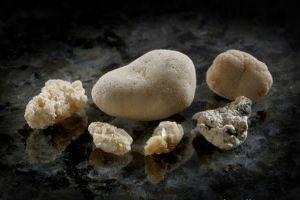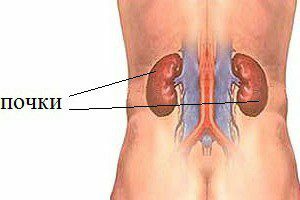disease Phosphate kidney stones are considered the most dangerous kidneys. This type of stone has increased activity. For this reason, pathology can lead to surgical intervention. Independently to try to eliminate these data should not be. Such an impact can only exacerbate the situation. Any therapeutic effect should be carried out under the strict supervision of a specialist.

The nature of their origin should also be taken into account. The selection of proper nutrition and increased urination can help to partially slow the pathological process. Food suitable for this disease promotes the dissolution of stones and the removal of residues through the urinary system.
Nature of tumors
Urolithiasis is widespread among the population. This is due to the peculiarities of nutrition and the lack of physical activity. There are several types of stones that form in the renal pelvis. The most common are oxalate, urate and phosphate plaques.
Each of them is formed at a large content of a certain substance in the patient's urine. Oxalate stones are formed with a high content of oxalic acid in the urine. Urates are formed due to uric acid. Phosphate neoplasms affect the kidneys due to the increased accumulation of calcium-containing phosphoric salt.
These stones are easy to distinguish from the others due to their characteristic appearance. The surface of phosphates is flat, does not have any notches or irregularities. The color range can range from dark gray to white. Due to their structure, these stones do not damage the inner layer of the renal pelvis. But there is also a certain danger.
 Phosphates easily increase in size. It is this type of formation that is involved in the formation of coral stones in the kidneys. Corals can reach a size exceeding the size of the pelvis. In this case, the patient completely blocks the urinary system. If the patient does not receive timely medical assistance, he may die. When the phosphate is highly expanded, it is necessary to remove the entire kidney with its contents.
Phosphates easily increase in size. It is this type of formation that is involved in the formation of coral stones in the kidneys. Corals can reach a size exceeding the size of the pelvis. In this case, the patient completely blocks the urinary system. If the patient does not receive timely medical assistance, he may die. When the phosphate is highly expanded, it is necessary to remove the entire kidney with its contents.
A feature of these plaques is the characterization of their appearance. With other types of stones in the kidneys there is a cluster of small particles - grains of sand. Sand is gradually deposited on the surface of the epithelium of the kidney. A plaque forms on the wall. With the passage of time, additional particles appear on the plaque, which cause the formation of a stone.
Phosphate stones are formed in the pelvis itself. The suspension is formed in the urine if the epithelial layer is not working properly. The contractive work of the organ is accompanied by the process of joining the particles together. Small kidney stones appear in the kidney.
At this stage, you can quickly and painlessly eliminate the disease. But the peculiarity of this pathology is the absence of obvious signs of kidney stones.
For this reason, many patients go to the hospital with complaints about various diseases. Only an experienced specialist can quickly determine what caused panic in the patient. To confirm the diagnosis, the patient is sent for additional diagnostics. When examining the kidneys, a specialist can accurately confirm the diagnosis.
To correctly determine the nature of the stones, it is necessary to clarify the features of the patient's anamnesis. The diagnosis depends on the reasons that could affect the formation of tumors in the pelvis.
Causes of urolithiasis
There are several negative factors that activate the process of stone formation. Phosphates are formed for the following reasons:
- Inflammatory diseases of the urinary system;
- Infection of the body;
- Wrong choice of food;
- Violation of water regime;
- The climate in which the patient lives;
- Disturbance of metabolic processes.
 The formation of phosphate stones is often observed in inflammatory diseases of the urinary system. These pathologies cause a change in the work of the epithelial layer of the renal pelvis. Epithelium is necessary for the kidney to absorb various mineral compounds from the urine. Inflammation can damage part of the epithelium. This creates a site that is unable to function fully. This entails the accumulation of dangerous compounds in the urine. There is a stagnation of microelements. In the urine, a slurry is detected, which participates in the creation of phosphates.
The formation of phosphate stones is often observed in inflammatory diseases of the urinary system. These pathologies cause a change in the work of the epithelial layer of the renal pelvis. Epithelium is necessary for the kidney to absorb various mineral compounds from the urine. Inflammation can damage part of the epithelium. This creates a site that is unable to function fully. This entails the accumulation of dangerous compounds in the urine. There is a stagnation of microelements. In the urine, a slurry is detected, which participates in the creation of phosphates.
Kidney infection also has the same consequences. There is a large number of various bacteria that cause pathological changes in the kidneys. Phosphates often cause staphylococcal infection. This bacterium does not need oxygen. It is able to live in any conditions in which the temperature regime does not exceed 70 degrees. The bacterium attacks the beneficial microflora of the urinary system. There are sites on which the necessary bacteria are replaced by staphylococcus. The microbe does not perform the functions characteristic of useful microflora. Many compounds remain uncleaved. The accumulation of calcium salts causes the appearance of crystals in the urine. Crystals form phosphate stones.
Phosphate compounds are formed when the food choices are incorrect. Many patients who suffer from this disease have an attachment to dairy products. Milk, cheese and sour milk drinks contain a large number of calcium compounds. If a person consumes only such food, the disease is activated. It is necessary to know that phosphates increase their growth when adding various fruits and vegetables to dairy products. Especially in this case, berries are dangerous. When combined with lactic acids, they form a phosphate calcium salt. When collecting an anamnesis, the doctor must take this feature into account. A frequent cause of phosphate is precisely the abuse of fruit with milk drinks.
Urolithiasis affects those patients who do not support drinking. For proper functioning of the kidneys and epithelium, the patient should consume at least two liters of clean water per day. If the consumption of drinking water is lower than the norm, the kidneys do not work at full strength. Reducing urinary excretion leads to the formation of a suspension in the pelvis. Suspension is involved in the formation of phosphate stones.
 Physicians noted that urolithiasis is detected in people living in hot climates. Such weather conditions cause the body to waste water irrationally. The bulk of the incoming fluid is excreted from the body through the sweat glands. Some of the fluid consumes the lymphatic system. Residual amounts enter the kidneys. The minimum water content in the kidneys causes stagnation of trace elements. The pelvis does not display the contents completely. Gradually, the kidney affects urolithiasis.
Physicians noted that urolithiasis is detected in people living in hot climates. Such weather conditions cause the body to waste water irrationally. The bulk of the incoming fluid is excreted from the body through the sweat glands. Some of the fluid consumes the lymphatic system. Residual amounts enter the kidneys. The minimum water content in the kidneys causes stagnation of trace elements. The pelvis does not display the contents completely. Gradually, the kidney affects urolithiasis.
Signs of a Dangerous Disease
Phosphates have a specific structure. In this case, they do not cause damage in the kidney cavity. Such patients do not have a pronounced clinical picture at the first stages of the development of the disease. To suspect an initial stage of the disease is possible in the presence of the following symptoms in the patient:
- Changing the quality characteristics of urine;
- Soreness of the lumbar spine;
- Puffiness of the lower limbs;
- Change in the volume of urine output;
- Frequent exacerbations of cystitis or pyelonephritis.
Anxiety can cause a change in the quality of the urine output. It changes color. Often with phosphate stones, urine becomes cloudy and lighter. This is the main feature of this disease. There may also be a significant decrease in the volume of urine. This is due to a decrease in free space in the pelvis.
Urinary excretion in such patients is accompanied by increased soreness in the lumbar spine. The pain persists in a calm state, but has a less pronounced character. Also, tenderness can also be detected in the act of defecation. This is due to increased spasm of the muscular framework of the small pelvis.
Urinary retention in the kidneys in many cases causes edema of the lower extremities. Puffiness gradually strengthens. Later the patient experiences difficulty in wearing shoes.
A secondary symptom of phosphate stones in the kidney is a frequent exacerbation of pyelonephritis or cystitis.
The patient often visits the toilet. Urine is excreted slowly in a small volume. Eliminate all these symptoms only with the help of properly selected treatment. Therapeutic effect is selected after a number of diagnostic measures.
Methods of therapeutic effect on
Disease phosphate neoplasms can be removed from the kidney by various methods. Selection of therapy depends on the stage of the disease. At the initial stage, you can do with the selection of a special diet. In this case, the patient is prohibited from consuming milk drinks. From food, berries and some vegetables are eliminated. It is also necessary to increase the amount of fluid consumed. Different teas and coffee are not taken into account.
If the pathology develops further, it is necessary to connect funds that enhance daily diuresis. They contribute to increased fluid flow through the renal pelvis. The liquid seizes accumulated salts and removes them through the urinary system. Also prescribed drugs that promote the dissolution of stones. The last stage of the disease is eliminated only surgically. The patient is completely excised kidney, affected by phosphate.
Urolithiasis causes various complications in the patient's health. To eliminate all these unpleasant phenomena, it is recommended to visit the doctor at the first characteristic signs of pathology.



